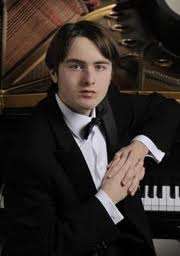|
Back
Turning keys into structures New York
Isaac Stern Auditorium, Carnegie Hall
02/05/2013 -
Alexander Scriabin: Sonata No. 2 in G sharp minor, “Sonata-Fantasy”, Op. 19
Franz Liszt: Sonata in B minor, S. 178
Frédéric Chopin: Préludes, Op. 28
Daniil Trifonov (Piano)

D. Trifonov (© Courtesy of the artist)
While Daniil Trifonov has played two concerti in New York–Tchaikovsky under Gergiev and Prokofiev under Gilbert–this was his first solo recital, and he made the most of it. Striding to the piano with a perfunctory bow to the packed audience, he launched into the first of three major pieces, and never stopped delivering until the last fireworks encore.
Not that Mr. Trifonov is a showman per se. His Liszt technically speeded up right after the introduction, but this was no blockade against giving depth to all Liszt’s variegated emotions. His molto agitato of the 22nd Chopin Prelude was done with faultless precision, but he just as beautifully handled the “Raindrop” Prelude.
And to begin with one of the early Scriabin Sonatas was pure audacity on his part. The Second Sonata begins with almost an improvisatory movement, a a bit of Chopin, a little Schubert, a few paths to Debussy. But it’s usually not a crowd-pleaser.
Nor did Mr. Trifonov try to make it something different. If one could classify a particular asset of the pianist, it’s how he loves the sounds of his Steinway. No, he doesn’t caress the keys, he has no affectations. But in this first movement, you could feel that he was devoted to all the drifting Scriabin lines, leading to a surprising fortissimo centerpiece. The Presto movement was easier to absorb. This was Trifonov the technician easily imitating what must have been Scriabin the pianist, showing his skills without showing off.
The following Liszt Sonata started, like the Scriabin, with a few drifting dark keys. But when the pianist launched into the major sections, one felt a muscularity. Not so much a digital muscularity (that was taken for granted at this point), but the strength of Liszt’s ideas themselves. For this Sonata was not one of the composer’s liquid salon pieces. This was a revolutionary idea in structure and harmony, and above all, in thought.
For that, Mr. Trifonov went at it with ferocity. Again, not the ferocity of the fingers, but a white-hot intensity which again, must have reflected Liszt’s own incandescent concentration in writing it. Not that Mr. Trifonov was afraid of utter beauty in the slower sections. Not mawkish beauty, but simply a sense that these wonderful lines were there to frame, even to emphasize the magnificence of the work as a whole.
It was not a daring or impressive performance. It was a Liszt that was overwhelming for its music more than its performer.
The Chopin Preludes from this performance turned out to be not 24 separate studies or pictures, but a complete fresco of colors and tempos. He avoided the sweet, gave stateliness to the funereal and turned those whirlwind sections into works of dazzling energy.
A no-nonsense artist, he played his three encores almost immediately but they were wondrous. The first, I believe by Medtner, the second Bach’s famous Bourrée. And finally an arrangement from the “Infernal Dance” from Firebird that was virtually an orchestra in itself. Was this pure technical delight? Perhaps so, but after such a mature realization of the preceding works, he could well afford to give us pyrotechnics for their own sake.
Harry Rolnick
|